
|
Feedback Form

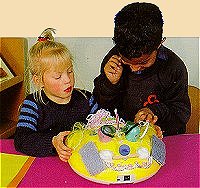
ROAMER, TURTLE AND MEASUREMENT 4

The previous few editions of GO have looked at some of the issues of measurement and how activities with Roamer or Turtle highlight some of the powerful and subtle ideas at the heart of the topic. So far these principles have been applied to activities involving linear measurement. Now GO looks at the measurement of turning.
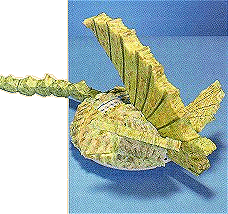 Prehistoric monster made from foam. |
The tenets outlined for linear measurement are valid for all types of measurement:
• Measurement is the comparison of one thing with another.
• Measurement is an approximate affair.
• Units are arbitrary - standard units are an adult convention.
• Estimation is an important skill.
When it comes to the measurement of turning, these ideas tend to be obscured by the predominance of the degree as a unit. One could be forgiven to think that it was the only unit of turn. However, the famous phrase "bandits at 12 o'clock" used by Battle of Britain pilots shows that this is not true. Other systems include the compass, radians used by scientists and the number of turns or revolutions.
If you start at one point and do a complete turn you should finish at the same point; this type of check does not exist in linear measurement. The absoluteness of the complete turn tends to obscure the approximate nature of measurement. Yet the principle still applies.
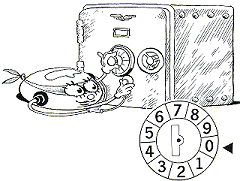
• Selina Safecracker
Selina Safecracker works nights. She has extra-sensitive sensors, which
allow her to hear the clicks on safe combinations. When she's not out
cracking safes she does voluntary work for the RSPCR (Royal Society for
the Prevention of Cruelty to Robots). She has opened branches in several
prisons and was recently invited to the palace to receive an award. Unfortunately
she could not resist cracking the King's safe. Selina missed the ceremony
and has been living in luxury on a tropical island ever since.
Fix a ring to the robot with numbers 0 to 9 clearly marked on it. Place
the robot on the floor with the zero sector aligned with a pointer on
the floor. Set the units of turn so that  will turn the Roamer from 1 to 2. Invent a code, for example: Turn right
to sector two, left to sector six, right to sector four etc. Program the
robot to 'crack' the code and open the safe. Each step can be programmed
separately. Older children can write a program to be executed with one
press of GO.
will turn the Roamer from 1 to 2. Invent a code, for example: Turn right
to sector two, left to sector six, right to sector four etc. Program the
robot to 'crack' the code and open the safe. Each step can be programmed
separately. Older children can write a program to be executed with one
press of GO.
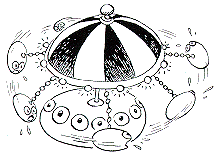
• Roamer Roundabout
Young Roamers taking a ride on the roundabout at Roamey Island Fair
never know how long the ride will last. The regulations state that the
roundabout should turn at least ten times. Unfortunately the time chip
in the roundabout contains a bug which can count to five and then starts
guessing. Once the roundabout started turning at 12 O'clock on New Year's
Day and didn't stop until the following Christmas. A schoolteacher had
to be lowered onto the roundabout to give the children lessons.
Make the Roamer into a roundabout. One pupil secretly sets the units of turn. The others have to program the 'roundabout' to turn 10 times with one press of GO.
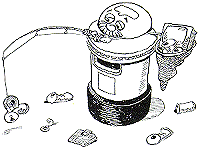
• Fishing
Roamers love fishing. All they need is a rod, a line and a place to
sit. They don't even need fish or water. A wide variety of grippers, hooks
and magnets allow them to fish anywhere. A favourite spot is on top of
a letter box in a busy street. The catch usually includes empty cans,
old TVs or the occasional dropped wallet, but sometimes another Roamer
is caught. Roamers consider it good luck to be caught by a fisher. The
fisher and the catch have a chat and a cup of tea on top of the letter
box before the guest is lowered back to the street.
Make the Roamer into an angler. The 'fishing' rod should have a magnet on the end of the line and you should be able to raise and lower it. Place the Roamer on a box. Ask the children collect items that the magnet can pick up. Place these items around the 'fisher'. Program the robot to turn to positions where it can pick up the 'fish'.
You can do this manually or get older children to use the Roamer Control features to design a mechanism to do it. If you do the latter: program the lower and raise as a procedure so that the younger pupils enter a procedure, say P 1, to catch the 'fish'.
• The Race to the North Pole
Roamundsen and Rott were two explorers, both eager to be the first
Roamer to stand at the North Pole. They set out from Roamer City in Spring
and returned two years later. Both had opened cafes on the Roamerterranean
Coast. They had forgotten to take compasses and had gone South instead
of North. Meanwhile a group of Roamers on a package holiday to Torroamerlenos,
who also forgot to take compasses, became the first Roamers to reach the
North Pole.
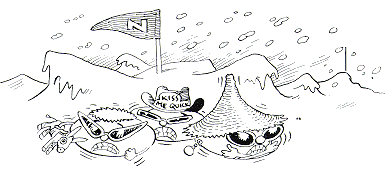
Make an explorer Roamer. Fit it with a compass. Set the units of turn to match the points on the compass. Make a set of cards with the compass points marked on them. Each child takes a card and programs the Roamer to face in that direction.
| Back |
|---|